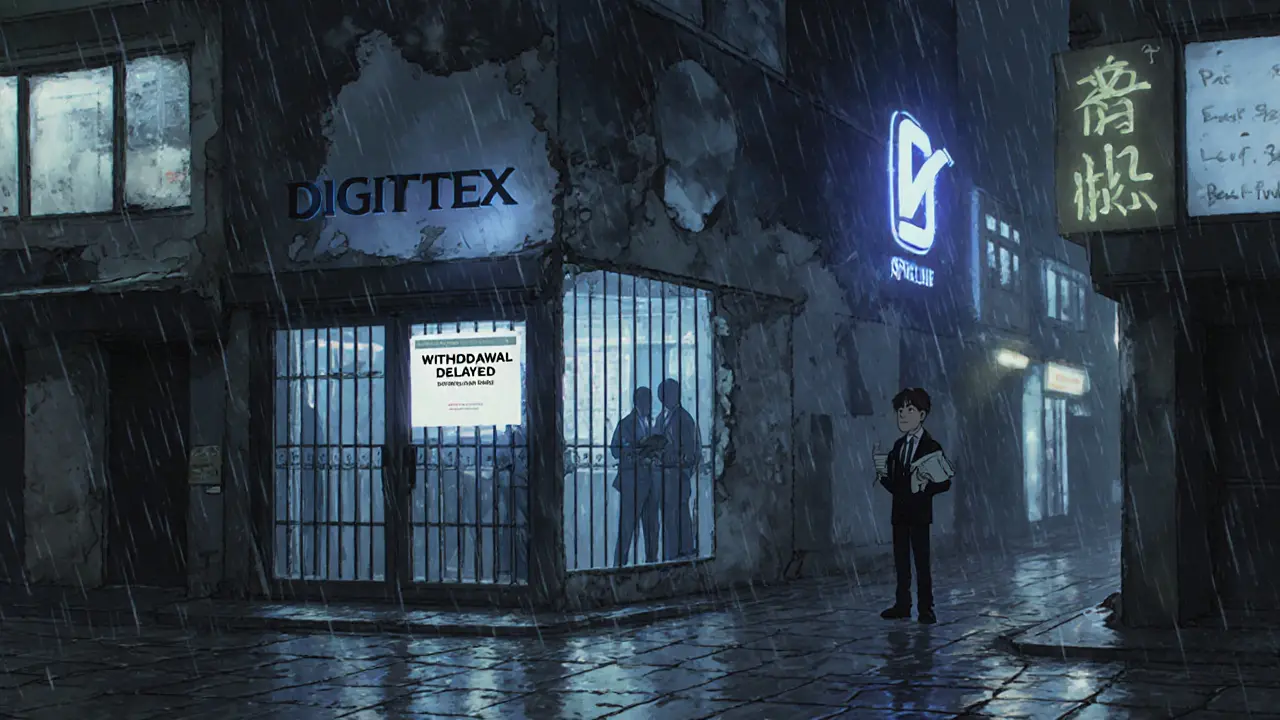Digitex Futures Risk Calculator
This calculator estimates potential outcomes for trading on Digitex Futures based on key factors including your initial investment, leverage level, and token holding requirements.
When Digitex Futures was a Seychelles‑based crypto derivatives platform that promised commission‑free futures trading using its native DGTX token, the idea sounded like a dream for traders tired of fee eating up profits. The promise was simple: hold DGTX, trade futures without paying a commission, and the platform would make money from token sales and other services. In practice, the exchange ran into a wall of regulatory, usability, and trust issues that culminated in a forced shutdown in 2025. This review breaks down what the service offered, why it failed, and what happened to the community afterward.
TL;DR
- Commission‑free futures were true, but you needed to hold DGTX tokens and meet a $5,000 minimum deposit.
- Regulatory gray‑area and lack of oversight gave the platform a 1/5 trust rating.
- Customer support was poor, withdrawals were frequently delayed, and the exchange shut down in 2025.
- Post‑shutdown, the project was rebranded as Rogue Chain a decentralized network governed by the Rogue DAO with a 1:1 DGTX‑to‑ROGUE token swap.
- For traders seeking regulated futures platforms, alternatives like Binance Futures or Bybit remain safer choices.
How Digitex Futures Tried to Disrupt the Futures Market
The core of Digitex’s value proposition was its DGTX token a utility token used to unlock commission‑free trading on the platform. Users had to purchase and hold DGTX in a dedicated wallet; the more tokens you held, the higher your leverage limits. By removing traditional maker/taker fees, the exchange claimed traders could keep 100% of their profits.
While the fee model was attractive on paper, the economics were shifted elsewhere. The platform generated revenue by selling DGTX during token‑sale events, charging higher spreads on certain contracts, and offering premium services like leveraged positions beyond the standard tier. The high barrier to entry-an initial $5,000 deposit-and the requirement to own a volatile token made the offering more suited to experienced traders with deep pockets.
Platform Features, Tools, and Limitations
Digitex Futures provided a basic web interface and a mobile app, both showing standard futures charts, order‑book depth, and a simple risk‑management panel. However, compared with industry leaders, the feature set was thin:
- Only a handful of major crypto contracts (BTC, ETH, SOL) were available.
- No advanced order types beyond limit and market orders.
- Limited API documentation, making algorithmic trading difficult.
- Platform and tools rating: 2/5 (according to community surveys).
The high minimum deposit and lack of educational resources meant retail traders had a steep learning curve. The “commission‑free” label also masked hidden costs such as wider bid‑ask spreads on less‑liquid pairs.
Regulatory and Safety Red Flags
From launch, Digitex operated in a regulatory gray area. The exchange was registered in the Seychelles but held no licenses from major financial authorities like the FCA, SEC, or MAS. This lack of oversight contributed to a trustworthiness rating of just 1/5. Users had no recourse if the platform froze funds or went offline.
In early 2025, U.S. regulators flagged the platform for violating securities laws related to derivatives trading without proper registration. The legal pressure forced the company to cease operations by September 2025, leaving users scrambling to withdraw assets.

User Experience: Support, Withdrawals, and Community Sentiment
Customer service was consistently rated 1/5. Support tickets often went unanswered for weeks, and live chat was unavailable outside limited business hours. Withdrawal requests frequently stalled; many users reported delays of 7‑10 days or more, sometimes resulting in partial reversals due to “network congestion.”
On Trustpilot a consumer review platform, Digitex Futures held a 3.8‑star rating from 166 reviews as of September 16, 2025. While some praised the zero‑commission model, the majority of negative feedback centered on withdrawal hiccups and poor support.
The Aftermath: From Digitex to Rogue Chain
After the shutdown, a European entity acquired the project's codebase and rebranded it as Rogue Chain a decentralized network overseen by the Rogue DAO. Existing DGTX holders were offered a 1:1 swap for ROGUE tokens, preserving their stake in the ecosystem.
High‑roller NFT owners also received replacement Rogue Pit Boss NFTs NFTs that act as validator node licenses on the Rogue Chain, mirroring the rarity traits of the original Digitex High Rollers NFTs. This move aimed to retain community value while sidestepping the legal constraints that plagued the original platform.
Market Outlook for the DGTX Token
Even after the exchange’s closure, DGTX continued trading on third‑party services like Changelly a crypto swapping service offering over 700 trading pairs. Price forecasts for 2025 were mixed: some models projected a modest 33% upside to $0.00004779, while others anticipated a decline to $0.00002921. The average sentiment leaned bearish, with 2026 projections suggesting a potential -4% ROI.
Traders should treat DGTX as a high‑risk asset, especially given its association with a defunct exchange and ongoing legal uncertainties.
How Digitex Stacked Up Against the Competition
| Feature | Digitex Futures | Binance Futures | Bybit |
|---|---|---|---|
| Commission | 0% (requires DGTX token) | 0.02% maker / 0.04% taker | 0.025% maker / 0.075% taker |
| Minimum Deposit | $5,000 | $10 (varies by asset) | $10 (varies by asset) |
| Regulatory Status | Unlicensed, gray area | Regulated in several jurisdictions | Regulated in several jurisdictions |
| Supported Contracts | Limited (BTC, ETH, SOL) | Wide range (50+ assets) | Wide range (50+ assets) |
| Customer Support Rating | 1/5 | 4/5 | 4/5 |
| Trustpilot Rating | 3.8/5 (166 reviews) | 4.4/5 | 4.2/5 |
Pros & Cons Checklist
- Pros
- Zero commission when holding DGTX.
- Innovative token‑based revenue model.
- High leverage options for token holders.
- Cons
- High $5,000 entry barrier.
- No regulatory license - high legal risk.
- Poor customer support and slow withdrawals.
- Limited asset selection and toolset.
- Shutdown in 2025 left users scrambling.

Frequently Asked Questions
Is Digitex Futures still operational?
No. The exchange was forced to shut down in September 2025 after running afoul of U.S. securities regulations. Users were instructed to withdraw assets before the platform ceased trading.
Can I still trade DGTX tokens?
Yes. DGTX remains listed on several third‑party swap services like Changelly. However, its price is volatile and the token lacks a primary utility after the exchange’s closure.
What happened to my Digitex NFTs?
Owners of the original High Rollers NFTs received a 1:1 swap for Rogue Pit Boss NFTs on the new Rogue Chain network. The new NFTs act as validator licenses and retain the original rarity traits.
Is the commission‑free model sustainable?
In theory, token sales and ancillary services can fund a zero‑fee structure, but the model proved fragile for Digitex. The high entry barrier and lack of diversified revenue streams made it vulnerable to regulatory action and market downturns.
Should I consider Binance Futures or Bybit instead?
Both Binance Futures and Bybit are regulated in multiple jurisdictions, offer extensive asset lists, and have robust customer support. They charge modest fees but provide far more security and liquidity than the defunct Digitex platform.







Amie Wilensky
May 31, 2025 AT 10:41When one surveys the wreckage of Digitex Futures, one cannot help but ask: what philosophical abyss did the architects of commission‑free futures fall into?; was it hubris, or simply a naïve belief that token economics could substitute for regulatory compliance?; the DGTX token, touted as the key, became a gilded cage-the very instrument of freedom that shackled users to volatility and mandatory holdings. Moreover, the platform’s insistence on a $5,000 minimum deposit, cloaked in the rhetoric of “serious traders only,” erected a barrier that excluded the very retail community that supposedly needed fee‑free access. The promise of zero commission, while seductive, masked hidden spreads, and the token‑sale revenue model suggested that the exchange was merely shifting the cost elsewhere. In short, the venture was a paradox: a “free” market that demanded payment in a volatile token, ultimately collapsing under regulatory scrutiny and user frustration.
Waynne Kilian
June 8, 2025 AT 04:47i think it's worth noting that while the whole DGTX story ended poorly, there were genuine attempts to innovate in the futures space. the idea of using a native token to offset fees was interesting, even if the execution failed. maybe future projects can learn from these mistakes and build something more sustainable. just hope they pay more attension to compliance next time.
Michael Wilkinson
June 15, 2025 AT 22:54The platform’s regulatory negligence is simply unacceptable; anyone claiming a “commission‑free” model without proper licensing is courting disaster. Users deserved transparency, and Digitix delivered none. This isn’t just a minor oversight-it’s a full‑blown breach of trust.
april harper
June 23, 2025 AT 17:01Alas, the rise and fall of Digitex reads like a tragic drama, a stage where ambition collided with reality. The curtain fell, leaving traders stranded, their hopes dissolving like vapor.
Kate Nicholls
July 1, 2025 AT 11:07From a risk perspective, the platform’s lack of licensing alone should have been a red flag. Coupled with the high entry barrier, it catered to a niche that might have been better served elsewhere.
Rajini N
July 9, 2025 AT 05:14For those still holding DGTX, you can move the tokens to any supported swap like Changelly. Just ensure you use a reputable wallet, double‑check the address, and be aware of network fees. If you need to exit, consider converting to a more liquid coin first.
Lindsay Miller
July 16, 2025 AT 23:21I feel for anyone who lost money when the exchange shut down; it’s a rough lesson about the importance of using regulated platforms.
Oreoluwa Towoju
July 24, 2025 AT 17:27Withdraw early, avoid the headache.
Jason Brittin
August 1, 2025 AT 11:34Wow, zero commission? Yeah, until you realize you’re paying with your sanity 😂. Good luck finding a platform that actually delivers.
Katrinka Scribner
August 9, 2025 AT 05:41Omg, that was a real mess lol! 😅 hope u get your funds back soon.
VICKIE MALBRUE
August 16, 2025 AT 23:47Stay positive, better options are out there.
Naomi Snelling
August 24, 2025 AT 17:54They didn’t just shut down because of “regulations” – it’s a clear sign of a coordinated effort to suppress decentralized finance and keep the old guard in power.
Clint Barnett
September 1, 2025 AT 12:01Let me walk you through the labyrinthine saga of Digitex Futures, a tale that intertwines ambition, naiveté, and a stark reminder that even the most glittering promises can crumble under the weight of reality. First, the allure of a commission‑free marketplace, powered by the DGTX token, seduced many traders who yearned for a haven free from the parasitic fees that gnaw at profit margins. Yet, behind that siren song lay a structural flaw: the platform demanded a hefty $5,000 minimum deposit, effectively gatekeeping access and alienating the very retail crowd that sought relief. Moreover, the token‑holding requirement forced users into speculative behavior, turning their capital into a double‑edged sword that could swing both ways. The regulatory vacuum in which Digitex operated was another ticking time‑bomb; without licenses from recognized authorities, the exchange was vulnerable to legal scrutiny, and that vulnerability manifested in 2025 when regulators descended like storm clouds. As the legal pressure mounted, the exchange’s support infrastructure buckled, leaving countless users staring at delayed withdrawals and unresponsive tickets. The community’s frustration boiled over, spawning a chorus of complaints on platforms like Trustpilot, where scores plummeted to dismal levels. In a desperate bid to salvage value, the team orchestrated a token swap to the newly minted Rogue Chain, offering a 1:1 exchange for ROGUE tokens-a move that felt more like a Phoenix rising from ashes than a genuine solution. Nevertheless, the shadow of the shutdown lingered, casting doubt on the credibility of any future token‑driven fee‑free model. For seasoned traders, the lesson is clear: one must weigh the seductive promise of zero fees against the concrete pillars of regulatory compliance, liquidity, and transparent governance. In the broader ecosystem, this episode serves as a cautionary tale, urging developers to embed robust compliance frameworks from the outset. Ultimately, while the DGTX token continues to flutter on secondary markets, its utility has been irrevocably tarnished, reminding us that innovation without sound foundations is a house of cards. So, as you navigate the ever‑evolving crypto derivatives landscape, remember to prioritize security, regulatory clarity, and community trust above the siren call of “free”.
Jacob Anderson
September 9, 2025 AT 06:07Oh, a “commission‑free” platform that requires you to buy its own token? Groundbreaking. Next they’ll tell us to bring our own coffee to the office.
Carl Robertson
September 17, 2025 AT 00:14The drama surrounding Digitex’s demise could rival any soap opera, but the underlying toxic negligence is the true villain. Ignoring compliance, inflating leverage, and then disappearing-pure melodrama for the masses.
Kate Roberge
September 24, 2025 AT 18:21Honestly, I think the hype was overblown; the platform wasn’t that terrible compared to some “big” exchanges that hide fees in the spread.
MD Razu
October 2, 2025 AT 12:27While you paint a vivid tableau of Digitex’s collapse, one must also consider the philosophical underpinnings of token‑based ecosystems: they embody the very tension between decentralization and centralized control, a paradox that inevitably generates friction. The DGTX token, in its quest for utility, became a symbolic sacrificial lamb, reminding us that liberty without responsibility is merely an illusion.
Charles Banks Jr.
October 10, 2025 AT 10:41Sure, because nothing says “trustworthy” like a platform that swaps your tokens faster than you can say “regulation”. 🙄